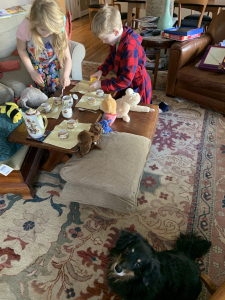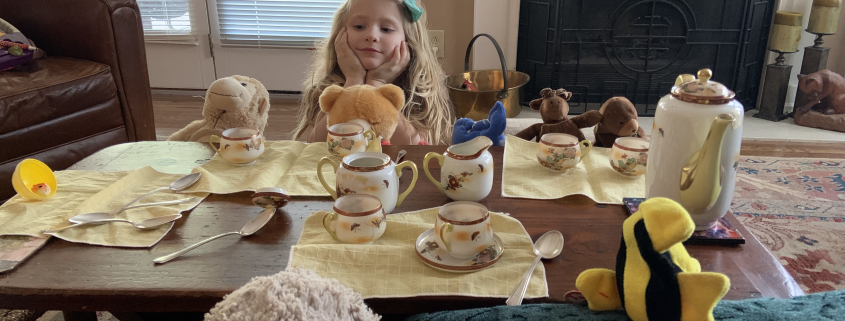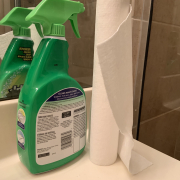It’s Tea Time
The accomplished hostess knows this fundamental truth of entertaining: Good parties tend to grow.
A little gathering at my place on a recent weekend morning started with just two guests, with my granddaughter Sis as hostess and me hovering in attendance nearby as kitchen staff.
“Evie, can we get out the tea set?” she had asked, beaming a little jolt of joy into my weary heart that morning. The tea set is a relic from my parents’ time at the American naval base in the Philippine Islands in the 1950s, an acquisition on a side trip to Hong Kong in those very different post-war times.
My granddaughter was a newborn when my mother downsized to smaller quarters and so many treasures went on to new destinations. I took the lovely teapot with its enchanting curved spout and the wafer-thin, gold-flowered cups and plates and stuck them in a drawer, wondering if they might appeal to her on some future lazy afternoon. On a recent day when we needed, shall we say, to redirect her focus, I had unwrapped them and conveyed them as hers, to remain for now in my care. “We’ll get them out soon and have a real tea party,” I offered, unsure if she even knew what that was.
That day was here.
As I reached for the location at the no-kids elevation where I stored the 60-year-old china, she installed the first two guests in their places at the coffee table, on a little bench and in a child’s rocker. The long, slender stuffed monkey displayed manners questionable for a tea party, his long arms flung behind him wildly as if on a bender, but I let it go. The raggedy, worn lop-eared bunny who faced him across the table displayed a rather detached expression for a party guest, but I let that go, too.
Shall I make some real tea? I offered, having saved a caffeine-free variety with a hint of cocoa in it for the children, and she answered, “Oh, yes, everyone wants tea.” I snapped to it in the kitchen, digging out a few of my grandmother’s shiny sterling teaspoons to add to the place settings. As I worked, more guests arrived. Next came a blue Kentucky Wildcat beanbag, who was never constructed for sitting up, a dark brown squirrel who held his ground rather nicely, another bear, and finally, a striped fish relic of a long-ago Disney movie. Fish needed an extra pillow to swim level with his teacup. Meanwhile, the real dog patrolled the perimeter nervously, certain this unauthorized activity required careful monitoring and watching me for instructions.
I held my breath as Sis, at her request, carefully poured the hot brew for each guest into the tiny cups. Not a drop spilled, reminding me again how trust fosters growth. With more focus on the spirit of the occasion than prudent nutritional practices for six-year-olds, I inquired if the guests preferred honey or sugar for their tea. What a rookie mistake; Sis is never one to pass up promising options. “They might want both,” she answered. I paused briefly over my error, then decided, why stop now?
Older Brother Buddy disdained this little charade at first, but as tea was poured and the gathering grew, he could not bear the sidelines. He came forward with a tiny rubber creature of undetermined species (possibly a video game character?) that was liberated from its small plastic case in time to claim a seat at the table. “He’s too small to drink from a cup,” Buddy worried about his little pal, about 1.5 inches long. Could he drink from a spoon? I asked. This was satisfactory, and soon the miniature creature was perched on a placemat in front of a silver spoon containing just a few drops of the amber liquid. The hostess and her brother sipped over-sweetened tea from different cups and spoons on their guests’ behalf, chatted sociably, and soon the little event wound to a conclusion.
My 89-year-old mother loves knowing when others enjoy her vintage things, so it was fun to tell her the tea-party story soon after. I shared photos showing the table set with her china, amusing her great-grandchildren more than half a century after she first acquired the tiny, gold-trimmed little pieces. She shook her head, amazed. “I didn’t know little girls still cared about those things,” she said, a bit wistfully. Within a few short days, there would be no immediate chances to reminisce with Mom over family photos, as her residence was closed indefinitely to visitors while pandemic rages on.
With such abrupt swiftness, our world has spun into a dark and unpredictable alternative reality in recent weeks. Everyone seems frightened and unbearably stressed. With each new dawn, the news continues to worsen, and on some days, hope may elude us.
And yet we press on. In her brilliant essay collection Late Migrations, author Margaret Renkl explores the intimacies of acute grief, but says that human beings are creatures who are built for joy. We look around, and we see that in defiance of global tragedy, spring still came, and the cherry trees have gracefully bowed down under the weight of their opalescent pink offerings. Golden daffodils stand forth in triumph to herald the coming of Easter. Musicians pour out their gifts before cameras instead of crowds, because deep in their marrow they know how music transcends, never more than in the hardest of times. Birds are boisterously caroling their mating and nesting plans, driving indoor cats mad with frustration through windows everywhere. From balconies across the ancient cities of Europe, strangers sing opera to the open air and applaud the heroism of healthcare workers who, if they are among the fortunate, they will never encounter.
And little kids still like tea parties.






